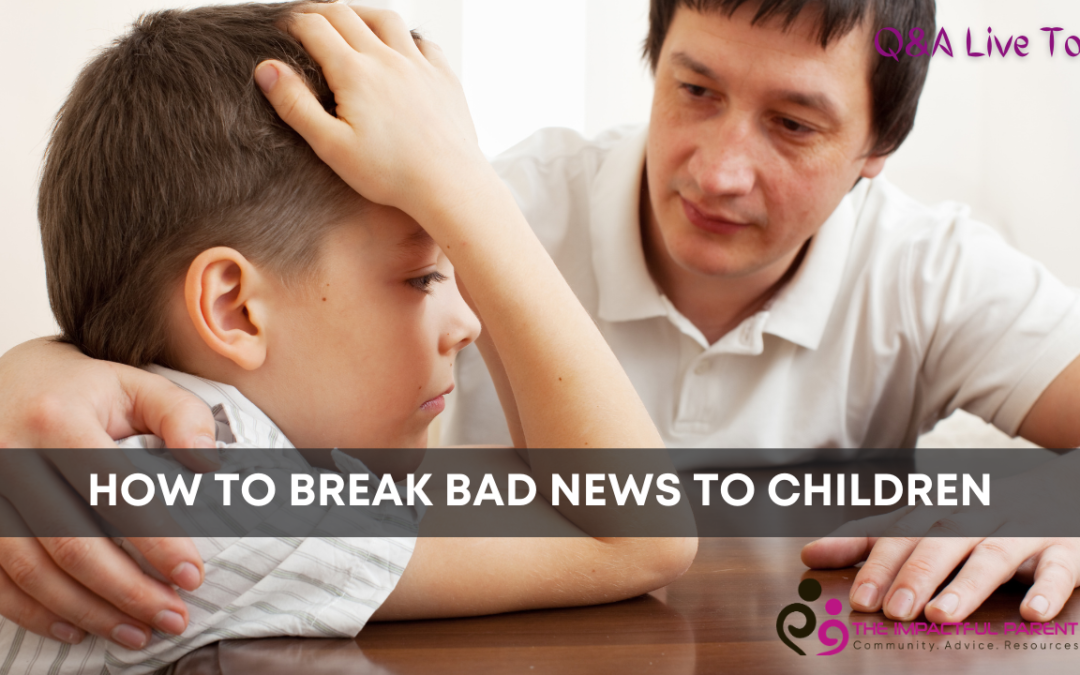How to break bad news to your child?
It is Question and Answer LIVE and today’s question was: How to break bad news to your child?
A step-by-step guide for breaking bad news to your child.
Step 1: Try and find a good environment.
- If possible, find a time that your child is not distracted.
- Find a private place.
- You’ll need to prepare yourself for spending some time with your child so try not to tell your child bad news when you don’t have the time to sit and process the information with them.
Step 2: Get your own feelings under control. You want to be your child’s anchor and support for the bad news. If your own emotions are radical, then you won’t be much help to your child. This is not to say that you don’t show emotions. It is good for your child to see your feelings, but you want to role model self-control even if you’re very sad yourself.
Step 3: Tell them the news directly. Don’t walk your way around the words or try and sugarcoat the situation. You want to break the news in the simplest and most direct form you can. For example, I have some sad news to tell you. Archie died this morning.

How to break bad news to your child?
Step 4: Pause and let your child process the news. Validate their feelings if they are sad, mad, confused, or whatever emotion they might be feeling. Tell them that their feelings are normal. Give your child a hug and simply listen to what your child might want to say. Empathize with your child as much as you can! It’s ok to say things like, I feel sad too. Being transparent with your own feelings is good; you just want to control those feelings.
Step 5: Prepare yourself for questions. I suggest waiting until your child has questions before telling them the details. I might tell them, “I am here to answer any questions you might have when you are ready.” Then be prepared to share the details at an age-appropriate level. Make your language as simple as possible because their emotions will likely be running high. The brain doesn’t process information as well in that state of being. Lastly, be prepared to repeat yourself again later. Sometimes hearing the news once just isn’t enough when a child is trying to understand the situation. Their brains aren’t working at full capacity because of all the emotions. Be patient with your child, and expect to repeat yourself now and later.
Step 6: Pause again and let your child process the information. The bad news is often complicated. I recommend you tell your child the details in segments. This allows your child to absorb the information in chunks and gives them opportunities to process feelings and ask questions. Although giving your child all the information at once might be your first instinct, try to reframe from this. Your mind and emotions will likely want to just get the information out and over with. Still, I don’t recommend you dump a load of information on your child. Instead, break it out into chunks and take your time.
Step 7: Once all the information is out, your child might feel overwhelmed. I suggest giving your child a small mindless task to do. This helps your child move forward and constructively process their feelings. You might ask your child to draw you a picture, make sandwiches, do a simple craft, or help you with laundry. Whatever it is, make sure that the task is mindless, simple, no-pressure, and has your child using their hands or body. While your child is doing their simple task, stay close by if they have more questions or just need company.
Step 8: Give your child a plan. Now that the bad news is out in the open and your child has had a little bit of time to process what is happening, it is now time to help your child understand what comes next. Have a discussion about the next steps. For example, suppose there was a death in the family. In that case, you want to talk about how in the next few days there will be a lot of family around, how they will likely miss school because of the funeral, and discuss how your child can help others that are grieving.

How to break bad news to your child?
You can also give your child a plan for helping them process their emotions. Maybe you talk about writing in a journal or creating art that expresses their feelings.
Giving your child a plan for the immediate future can feel comforting in a time of chaos.
Step 9: Lead by example. In my opinion, this is the most important step of all the steps because your child will watch how you handle stress, sadness, anger, frustration, and disappointment, and their instinct will be to emulate your behaviors. Model healthy coping behaviors. Model self-care.
Step 10: Tell others your child might need support. Remember that the first few days of bad news will be the most challenging; however, this is not the case for every child. Some kids will refuse to process their emotions right away and wait until the next day or even the next week to start asking questions. That’s ok. Be patient. However, either way, it is important to tell other adults around your child that your child may need extra support. For example, I would tell teachers, babysitters, and others in the household. Your child may process their feelings by acting out, getting aggressive, hiding, lying, eating more, eating less, … the list goes on. Still, any behavior out of the normal should be noted. Teachers and babysitters will have much more grace and patience with your child if they know that your child is processing feelings. Otherwise, your child might get in trouble at school, and teachers won’t have the empathy to help your child if they don’t know the situation.
——————————
Submissions for Q&A LIVE can be either emailed to The Impactful Parent directly or direct messaged through any of these social media platforms. Submissions are anonymous and are never mentioned in the Live Recording to respect the privacy of The Impactful Parent audience. Email: [email protected]
Don’t forget to check out all the FREE resources and tips that The Impactful Parent has to offer! theimpactfulparent.com
Make an authentic connection with your child. Try a FREE 30 Day Challenge. You’ll receive a new question to ask your child every day- for 30 days. Get away from the boring questions and start connecting with your child one question at a time! theimpactfulparent.com/connection
Follow The Impactful Parent on social Media! Facebook, Instagram, Linked In, Pinterest, and YouTube.

